CHERY TIGGO 2009 Service Repair Manual
Manufacturer: CHERY, Model Year: 2009, Model line: TIGGO, Model: CHERY TIGGO 2009Pages: 1903, PDF Size: 33.38 MB
Page 1321 of 1903
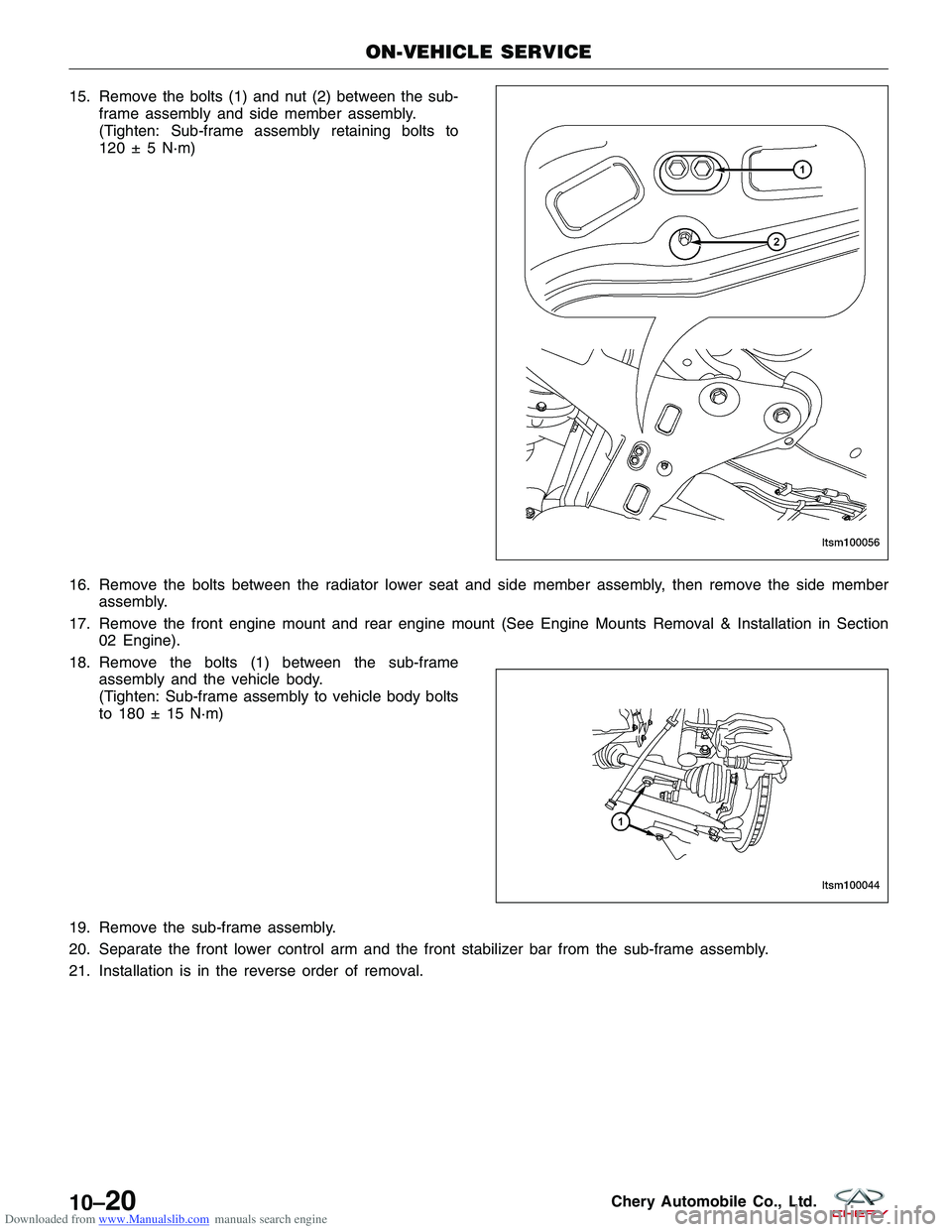
Downloaded from www.Manualslib.com manuals search engine 15. Remove the bolts (1) and nut (2) between the sub-frame assembly and side member assembly.
(Tighten: Sub-frame assembly retaining bolts to
120 ± 5 N·m)
16. Remove the bolts between the radiator lower seat and side member assembly, then remove the side member assembly.
17. Remove the front engine mount and rear engine mount (See Engine Mounts Removal & Installation in Section 02 Engine).
18. Remove the bolts (1) between the sub-frame assembly and the vehicle body.
(Tighten: Sub-frame assembly to vehicle body bolts
to 180 ± 15 N·m)
19. Remove the sub-frame assembly.
20. Separate the front lower control arm and the front stabilizer bar from the sub-frame assembly.
21. Installation is in the reverse order of removal.
ON-VEHICLE SERVICE
LTSM100056
LTSM100044
10–20Chery Automobile Co., Ltd.
Page 1322 of 1903
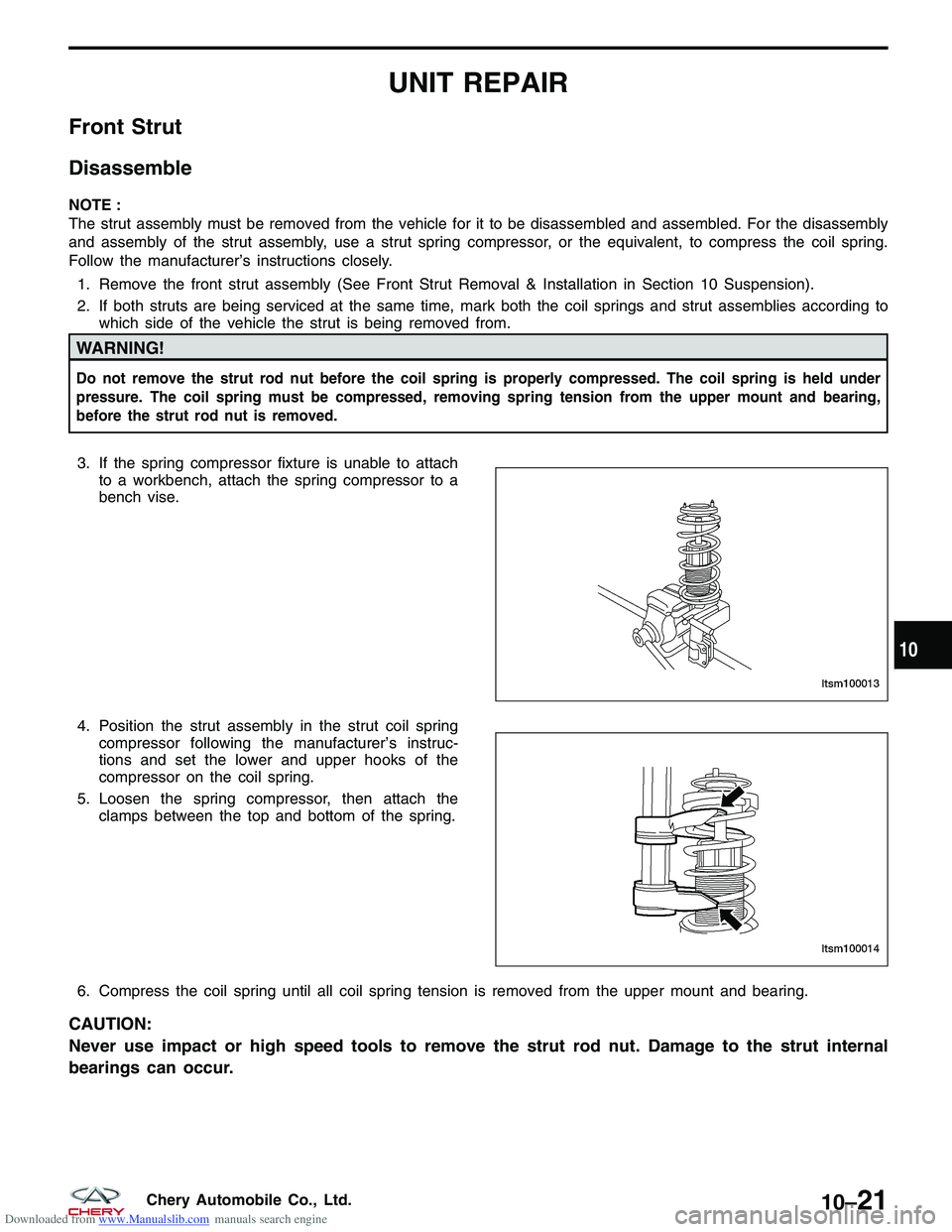
Downloaded from www.Manualslib.com manuals search engine UNIT REPAIR
Front Strut
Disassemble
NOTE :
The strut assembly must be removed from the vehicle for it to be disassembled and assembled. For the disassembly
and assembly of the strut assembly, use a strut spring compressor, or the equivalent, to compress the coil spring.
Follow the manufacturer’s instructions closely.1. Remove the front strut assembly (See Front Strut Removal & Installation in Section 10 Suspension).
2. If both struts are being serviced at the same time, mark both the coil springs and strut assemblies according to which side of the vehicle the strut is being removed from.
WARNING!
Do not remove the strut rod nut before the coil spring is properly compressed. The coil spring is held under
pressure. The coil spring must be compressed, removing spring tension from the upper mount and bearing,
before the strut rod nut is removed.
3. If the spring compressor fixture is unable to attachto a workbench, attach the spring compressor to a
bench vise.
4. Position the strut assembly in the strut coil spring compressor following the manufacturer’s instruc-
tions and set the lower and upper hooks of the
compressor on the coil spring.
5. Loosen the spring compressor, then attach the clamps between the top and bottom of the spring.
6. Compress the coil spring until all coil spring tension is removed from the upper mount and bearing.
CAUTION:
Never use impact or high speed tools to remove the strut rod nut. Damage to the strut internal
bearings can occur.
LTSM100013
LTSM100014
10
10–21Chery Automobile Co., Ltd.
Page 1323 of 1903
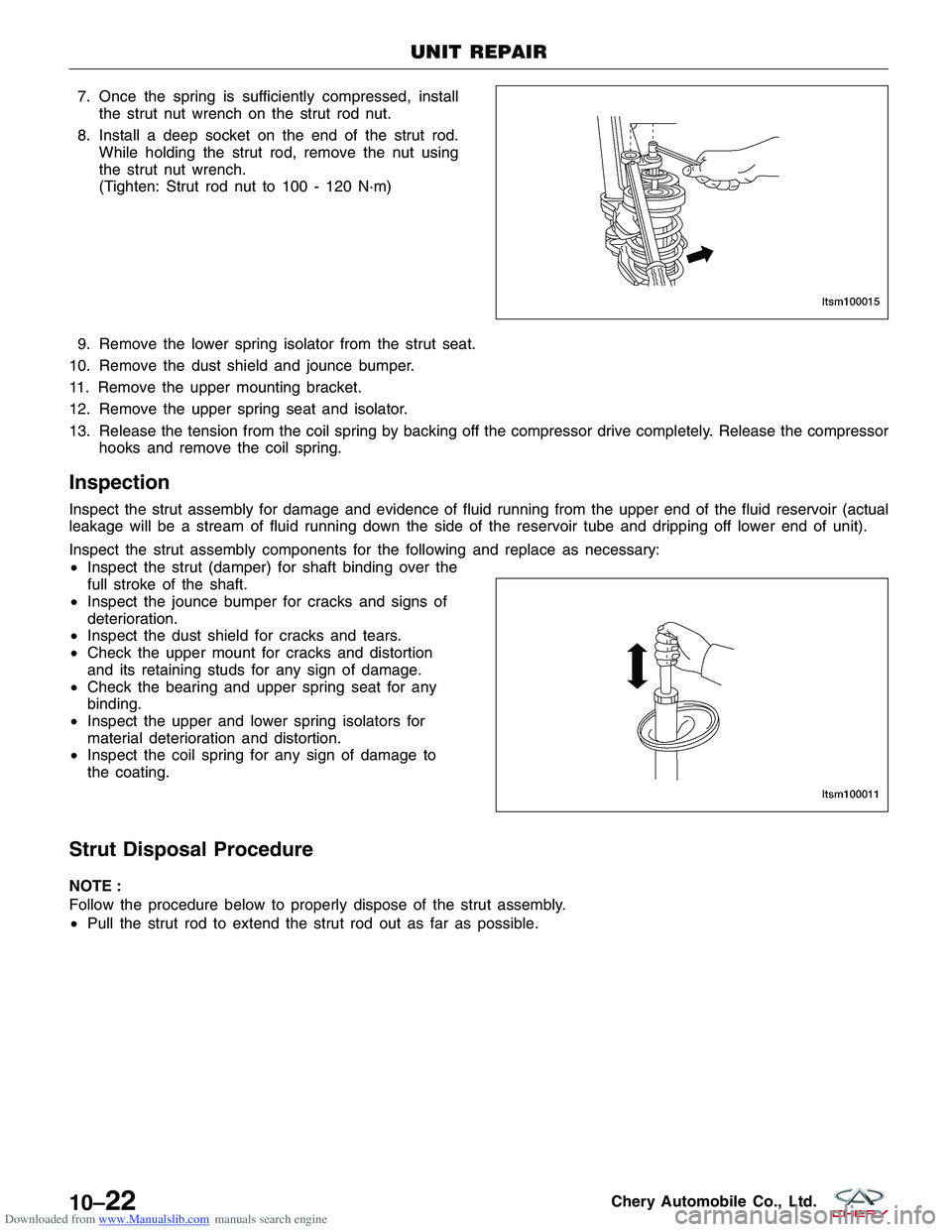
Downloaded from www.Manualslib.com manuals search engine 7. Once the spring is sufficiently compressed, installthe strut nut wrench on the strut rod nut.
8. Install a deep socket on the end of the strut rod. While holding the strut rod, remove the nut using
the strut nut wrench.
(Tighten: Strut rod nut to 100 - 120 N·m)
9. Remove the lower spring isolator from the strut seat.
10. Remove the dust shield and jounce bumper.
11. Remove the upper mounting bracket.
12. Remove the upper spring seat and isolator.
13. Release the tension from the coil spring by backing off the compressor drive completely. Release the compressor hooks and remove the coil spring.
Inspection
Inspect the strut assembly for damage and evidence of fluid running from the upper end of the fluid reservoir (actual
leakage will be a stream of fluid running down the side of the reservoir tube and dripping off lower end of unit).
Inspect the strut assembly components for the following and replace as necessary:
•Inspect the strut (damper) for shaft binding over the
full stroke of the shaft.
• Inspect the jounce bumper for cracks and signs of
deterioration.
• Inspect the dust shield for cracks and tears.
• Check the upper mount for cracks and distortion
and its retaining studs for any sign of damage.
• Check the bearing and upper spring seat for any
binding.
• Inspect the upper and lower spring isolators for
material deterioration and distortion.
• Inspect the coil spring for any sign of damage to
the coating.
Strut Disposal Procedure
NOTE :
Follow the procedure below to properly dispose of the strut assembly.
•Pull the strut rod to extend the strut rod out as far as possible.
UNIT REPAIR
LTSM100015
LTSM100011
10–22Chery Automobile Co., Ltd.
Page 1324 of 1903
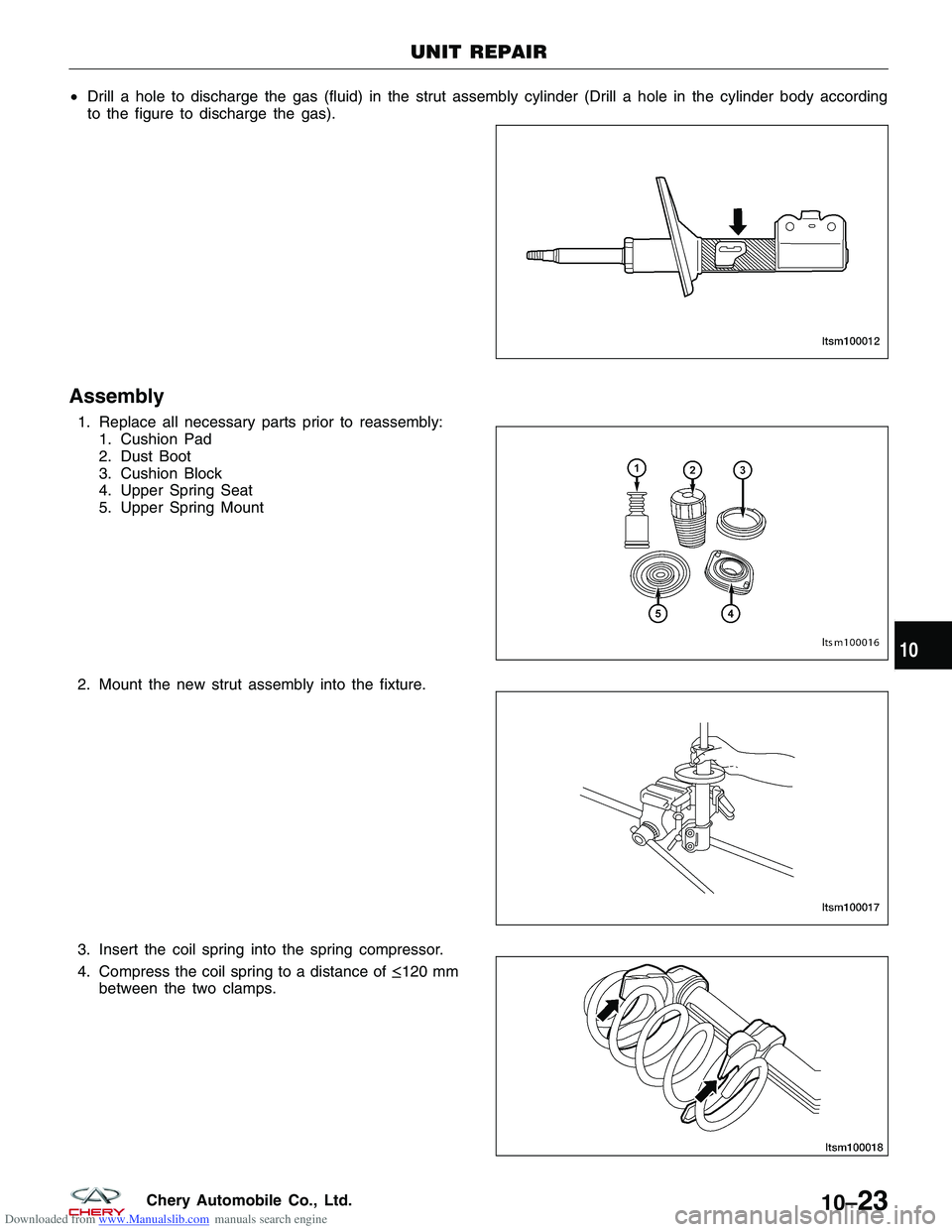
Downloaded from www.Manualslib.com manuals search engine •Drill a hole to discharge the gas (fluid) in the strut assembly cylinder (Drill a hole in the cylinder body according
to the figure to discharge the gas).
Assembly
1. Replace all necessary parts prior to reassembly:
1. Cushion Pad
2. Dust Boot
3. Cushion Block
4. Upper Spring Seat
5.
Upper Spring Mount
2. Mount the new strut assembly into the fixture.
3. Insert the coil spring
into the spring compressor.
4. Compress the coil spring to a distance of ≤120 mm
between the two clamps.
UNIT REPAIR
LTSM100012
LTSM100016
LTSM100017
LTSM100018
10
10–23Chery Automobile Co., Ltd.
Page 1325 of 1903
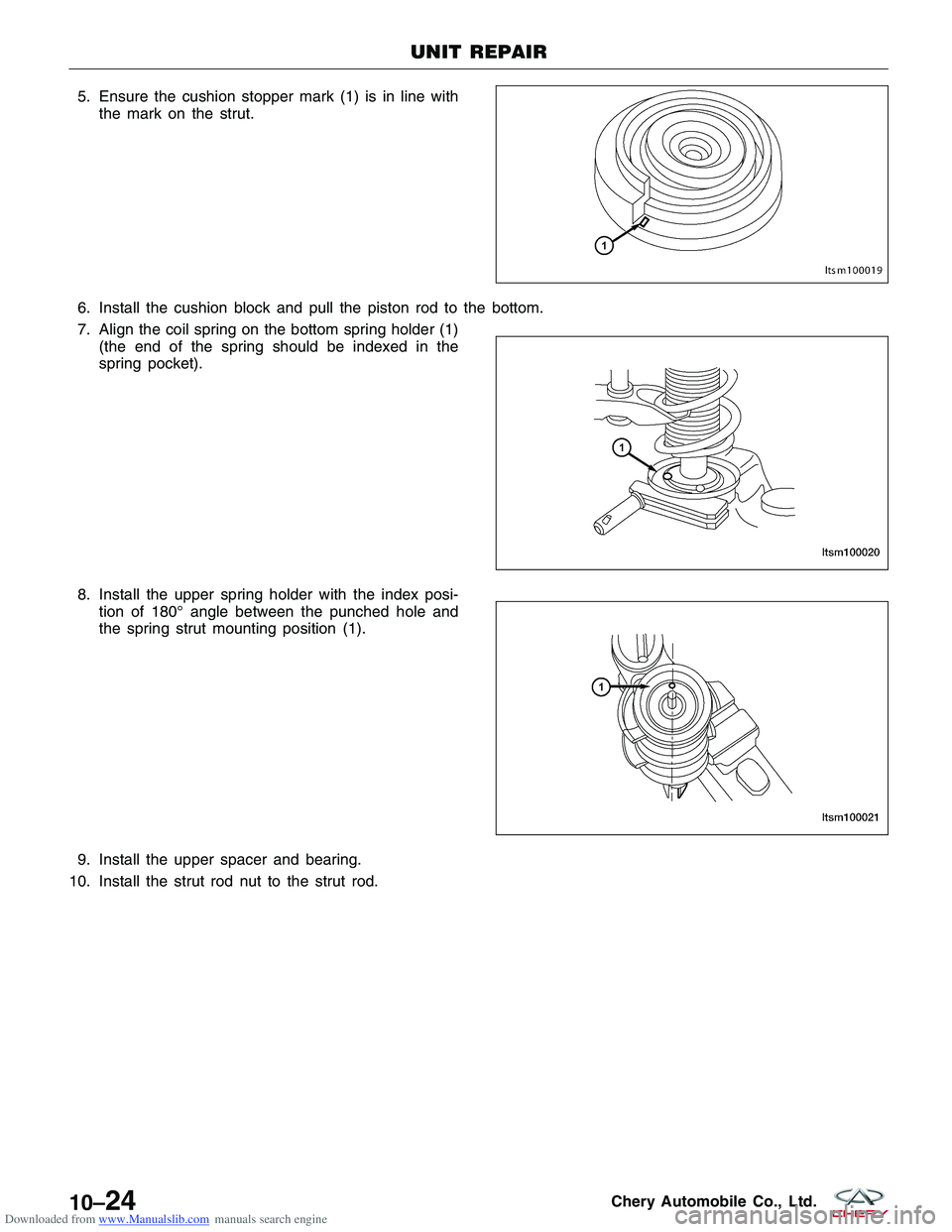
Downloaded from www.Manualslib.com manuals search engine 5. Ensure the cushion stopper mark (1) is in line withthe mark on the strut.
6. Install the cushion block and pull the piston rod to the bottom.
7. Align the coil spring on the bottom spring holder (1) (the end of the spring should be indexed in the
spring pocket).
8. Install the upper spring holder with the index posi- tion of 180° angle between the punched hole and
the spring strut mounting position (1).
9. Install the upper spacer and bearing.
10. Install the strut rod nut to the strut rod.
UNIT REPAIR
LTSM100019
LTSM100020
LTSM100021
10–24Chery Automobile Co., Ltd.
Page 1326 of 1903
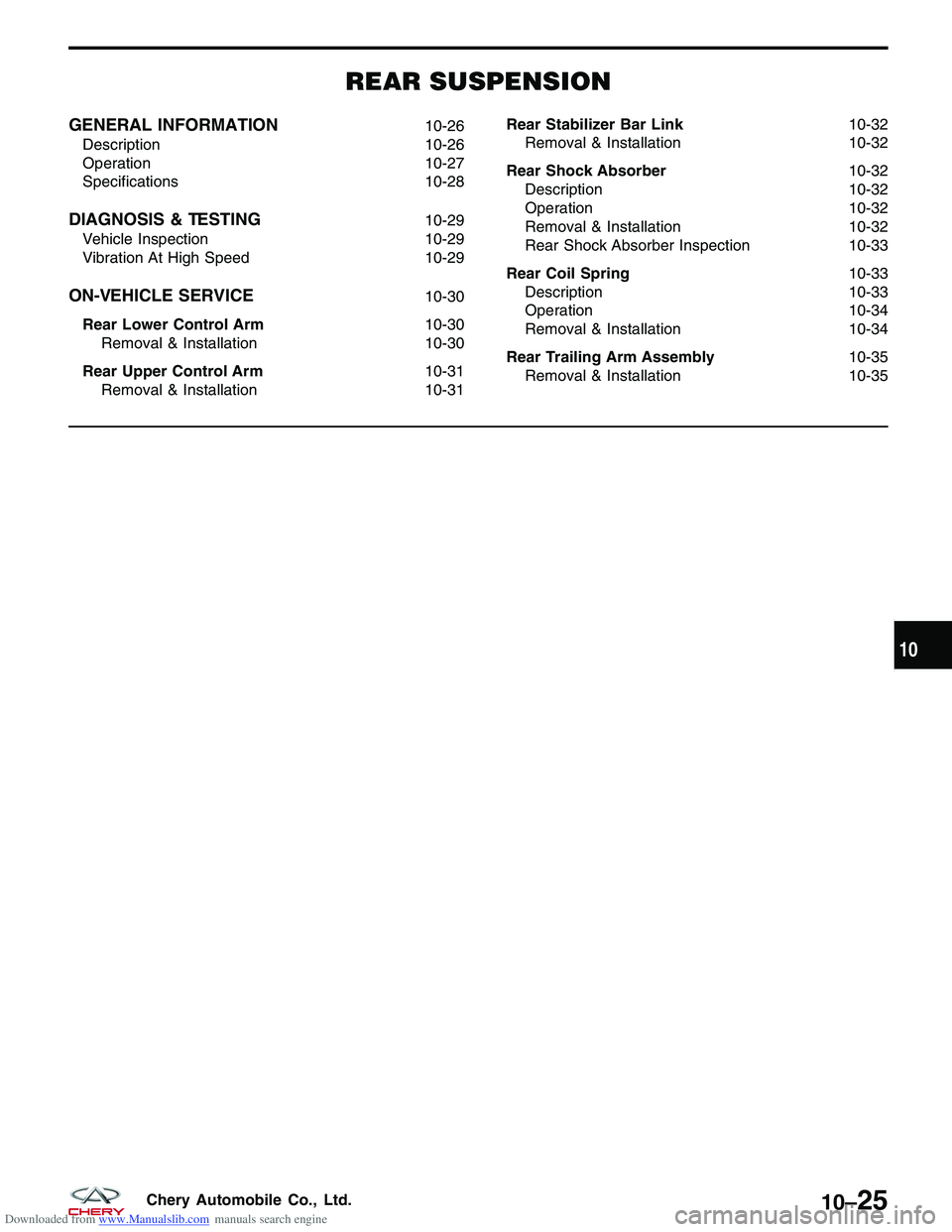
Downloaded from www.Manualslib.com manuals search engine REAR SUSPENSION
GENERAL INFORMATION10-26
Description 10-26
Operation 10-27
Specifications 10-28
DIAGNOSIS & TESTING10-29
Vehicle Inspection 10-29
Vibration At High Speed 10-29
ON-VEHICLE SERVICE10-30
Rear Lower Control Arm 10-30
Removal & Installation 10-30
Rear Upper Control Arm 10-31
Removal & Installation 10-31 Rear Stabilizer Bar Link
10-32
Removal & Installation 10-32
Rear Shock Absorber 10-32
Description 10-32
Operation 10-32
Removal & Installation 10-32
Rear Shock Absorber Inspection 10-33
Rear Coil Spring 10-33
Description 10-33
Operation 10-34
Removal & Installation 10-34
Rear Trailing Arm Assembly 10-35
Removal & Installation 10-35
10
10–25Chery Automobile Co., Ltd.
Page 1327 of 1903
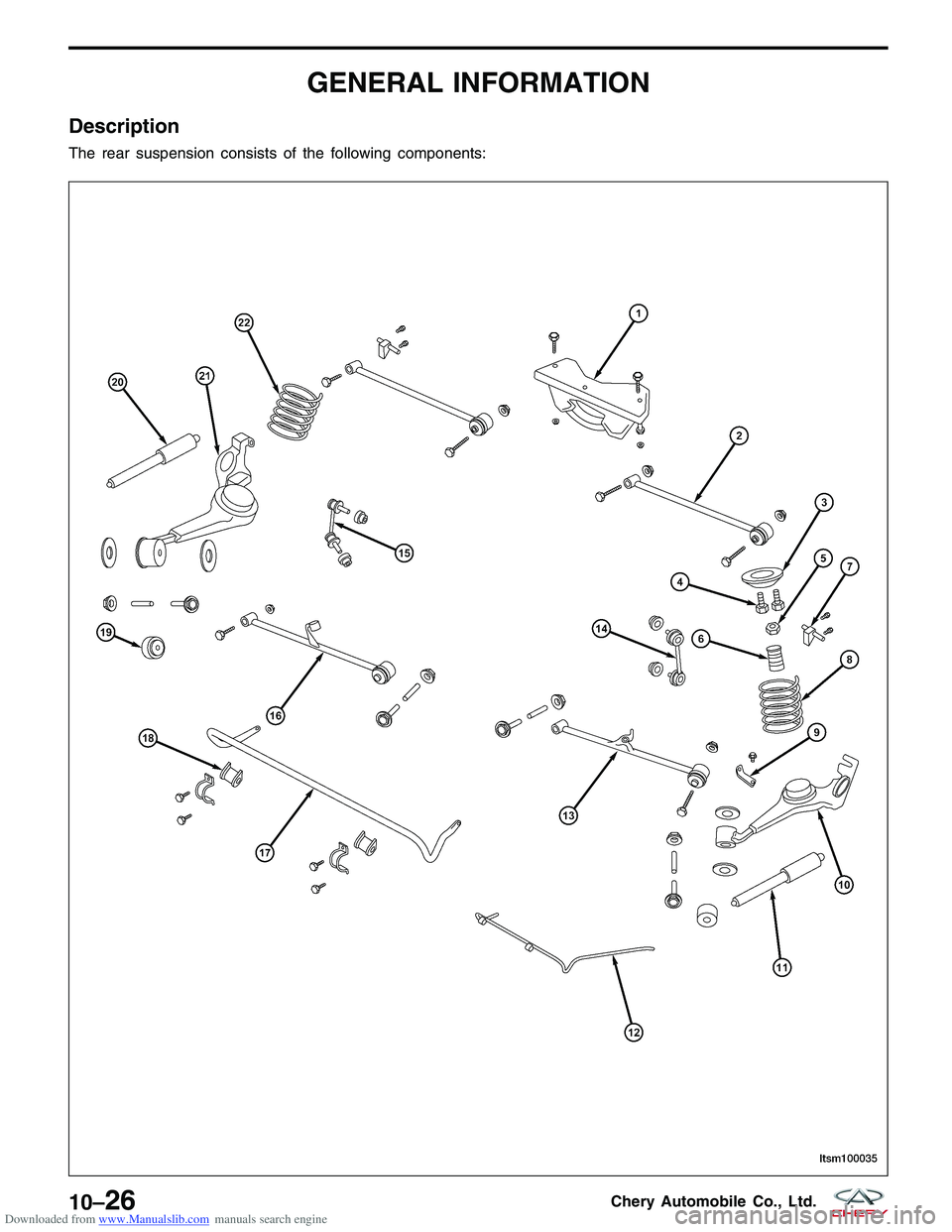
Downloaded from www.Manualslib.com manuals search engine GENERAL INFORMATION
Description
The rear suspension consists of the following components:
LTSM10003510–26Chery Automobile Co., Ltd.
Page 1328 of 1903
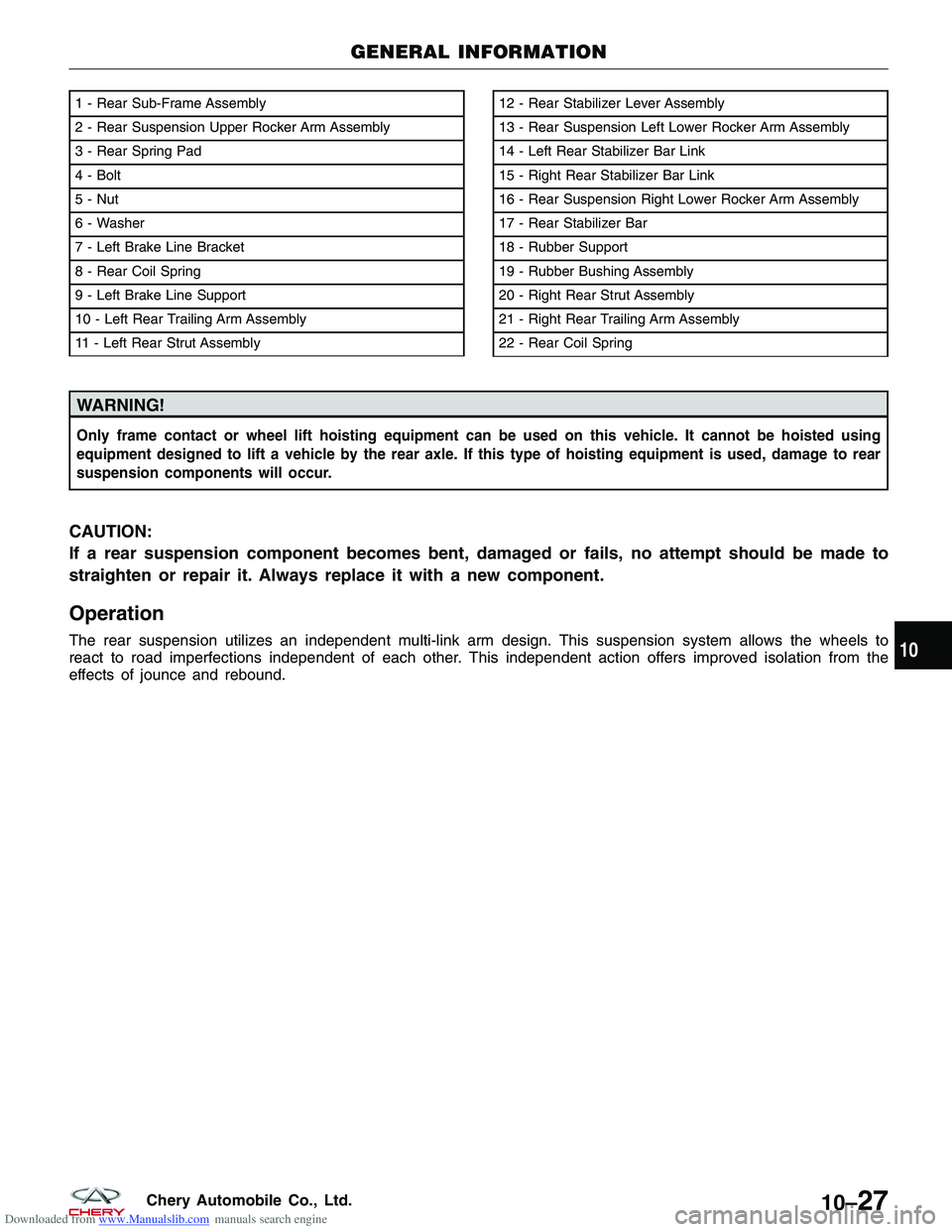
Downloaded from www.Manualslib.com manuals search engine WARNING!
Only frame contact or wheel lift hoisting equipment can be used on this vehicle. It cannot be hoisted using
equipment designed to lift a vehicle by the rear axle. If this type of hoisting equipment is used, damage to rear
suspension components will occur.
CAUTION:
If a rear suspension component becomes bent, damaged or fails, no attempt should be made to
straighten or repair it. Always replace it with a new component.
Operation
The rear suspension utilizes an independent multi-link arm design. This suspension system allows the wheels to
react to road imperfections independent of each other. This independent action offers improved isolation from the
effects of jounce and rebound.
1 - Rear Sub-Frame Assembly
2 - Rear Suspension Upper Rocker Arm Assembly
3 - Rear Spring Pad
4 - Bolt
5 - Nut
6 - Washer
7 - Left Brake Line Bracket
8 - Rear Coil Spring
9 - Left Brake Line Support
10 - Left Rear Trailing Arm Assembly
11 - Left Rear Strut Assembly12 - Rear Stabilizer Lever Assembly
13 - Rear Suspension Left Lower Rocker Arm Assembly
14 - Left Rear Stabilizer Bar Link
15 - Right Rear Stabilizer Bar Link
16 - Rear Suspension Right Lower Rocker Arm Assembly
17 - Rear Stabilizer Bar
18 - Rubber Support
19 - Rubber Bushing Assembly
20 - Right Rear Strut Assembly
21 - Right Rear Trailing Arm Assembly
22 - Rear Coil Spring
GENERAL INFORMATION
LTSM100035
10
10–27Chery Automobile Co., Ltd.
Page 1329 of 1903
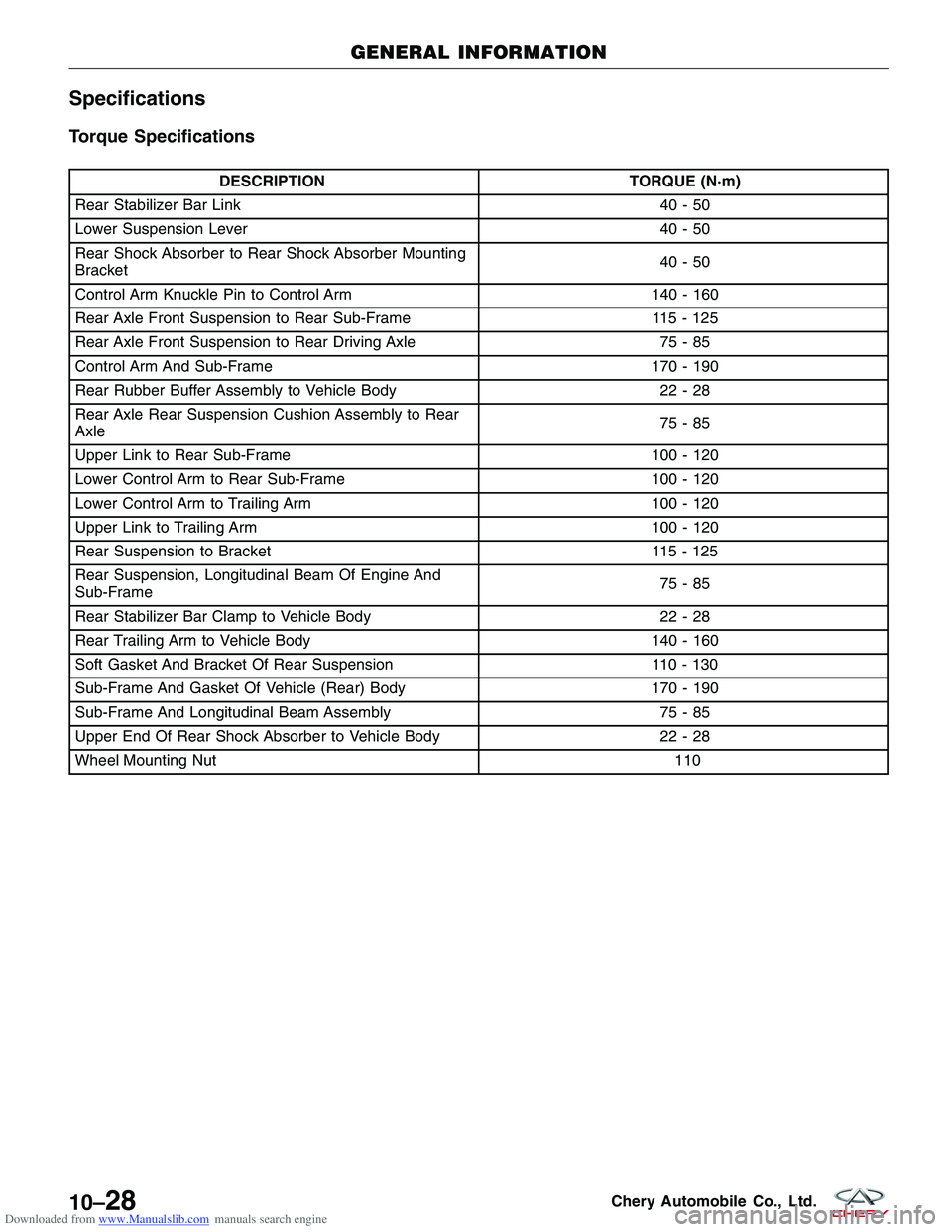
Downloaded from www.Manualslib.com manuals search engine Specifications
Torque Specifications
DESCRIPTIONTORQUE (N·m)
Rear Stabilizer Bar Link 40 - 50
Lower Suspension Lever 40 - 50
Rear Shock Absorber to Rear Shock Absorber Mounting
Bracket 40-50
Control Arm Knuckle Pin to Control Arm 140 - 160
Rear Axle Front Suspension to Rear Sub-Frame 115 - 125
Rear Axle Front Suspension to Rear Driving Axle 75 - 85
Control Arm And Sub-Frame 170 - 190
Rear Rubber Buffer Assembly to Vehicle Body 22 - 28
Rear Axle Rear Suspension Cushion Assembly to Rear
Axle 75-85
Upper Link to Rear Sub-Frame 100 - 120
Lower Control Arm to Rear Sub-Frame 100 - 120
Lower Control Arm to Trailing Arm 100 - 120
Upper Link to Trailing Arm 100 - 120
Rear Suspension to Bracket 115 - 125
Rear Suspension, Longitudinal Beam Of Engine And
Sub-Frame 75-85
Rear Stabilizer Bar Clamp to Vehicle Body 22 - 28
Rear Trailing Arm to Vehicle Body 140 - 160
Soft Gasket And Bracket Of Rear Suspension 110 - 130
Sub-Frame And Gasket Of Vehicle (Rear) Body 170 - 190
Sub-Frame And Longitudinal Beam Assembly 75 - 85
Upper End Of Rear Shock Absorber to Vehicle Body 22 - 28
Wheel Mounting Nut \
11
0
GENERAL INFORMATION
10–28Chery Automobile Co., Ltd.
Page 1330 of 1903
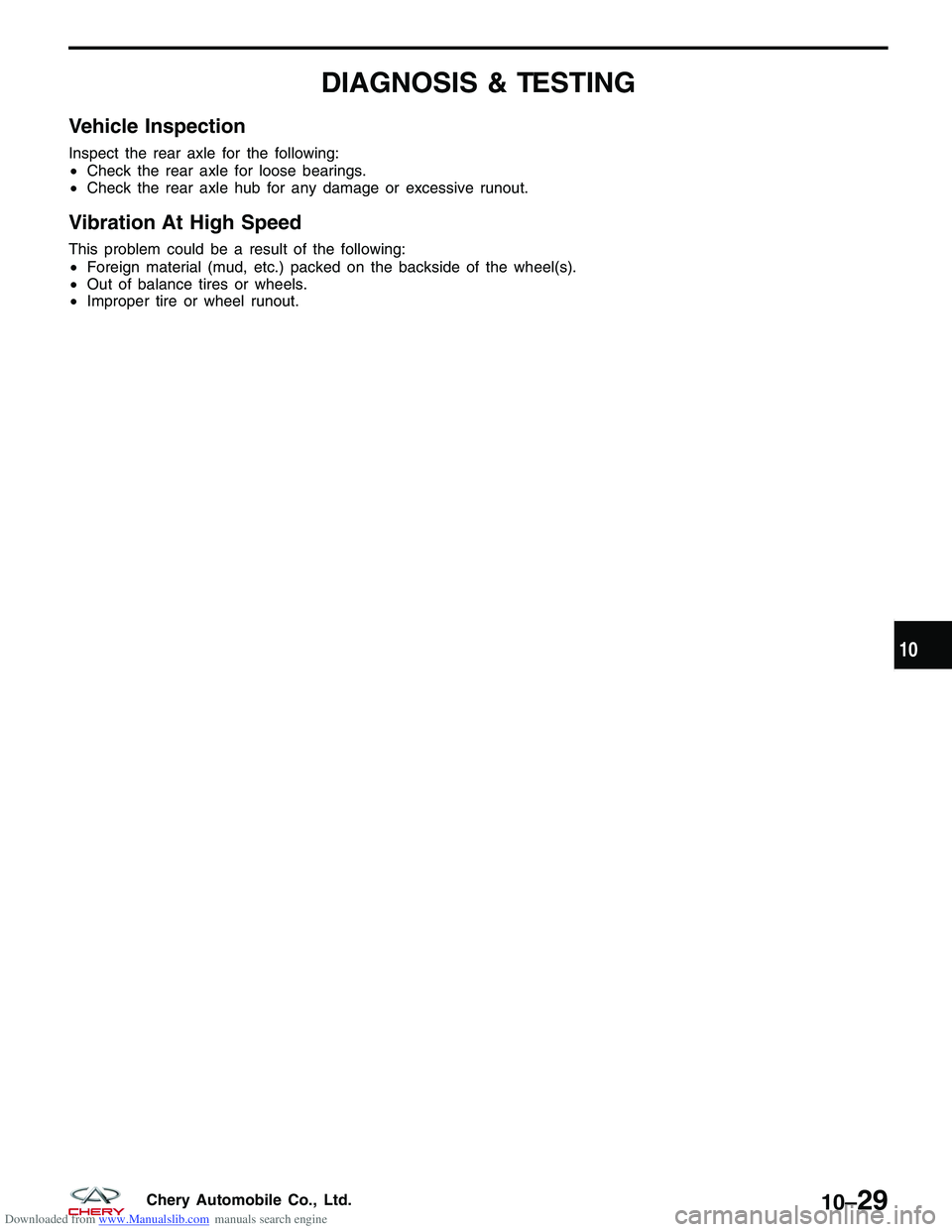
Downloaded from www.Manualslib.com manuals search engine DIAGNOSIS & TESTING
Vehicle Inspection
Inspect the rear axle for the following:
•Check the rear axle for loose bearings.
• Check the rear axle hub for any damage or excessive runout.
Vibration At High Speed
This problem could be a result of the following:
•Foreign material (mud, etc.) packed on the backside of the wheel(s).
• Out of balance tires or wheels.
• Improper tire or wheel runout.
10
10–29Chery Automobile Co., Ltd.